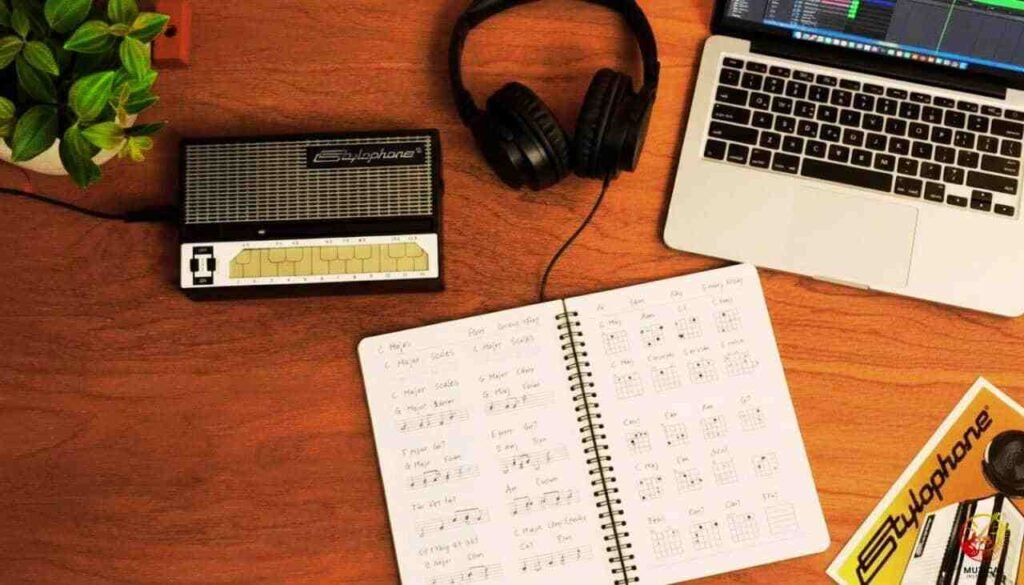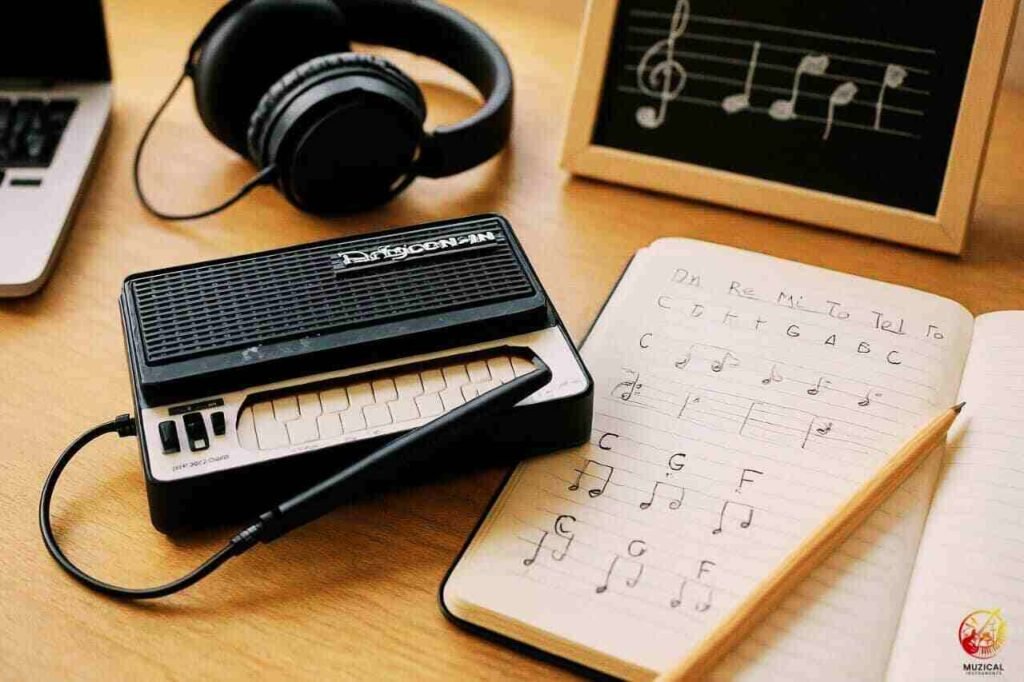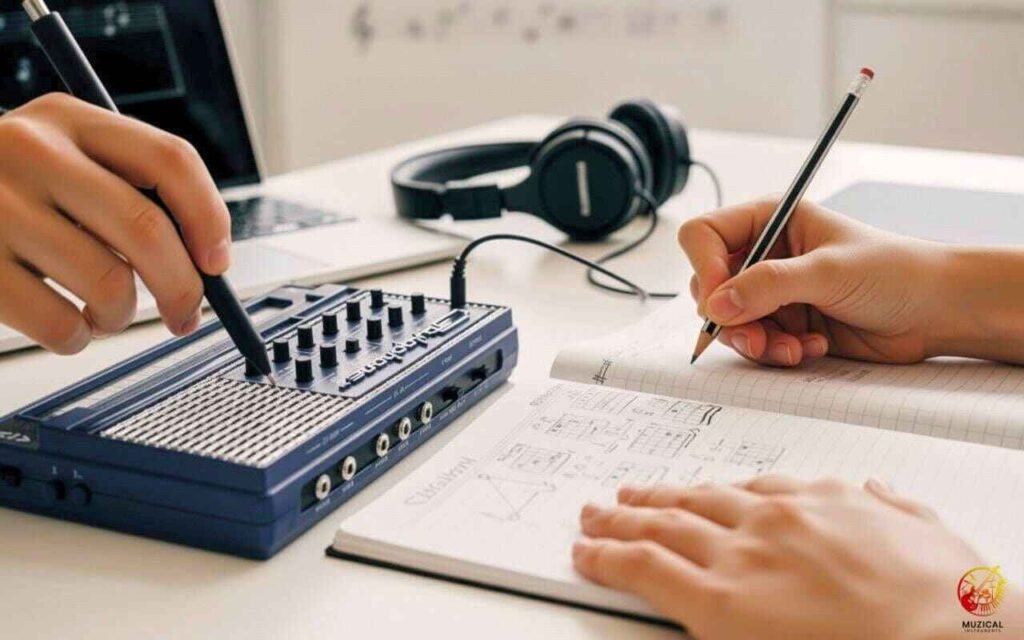How to Use a Stylophone for Learning Music Theory
The Stylophone is a tiny synthesizer you play with a pen-like stylus. At first glance, it looks simple, but that’s what makes it so powerful for learning. Instead of getting lost in complex instruments, you can jump right into hearing how notes, scales, and chords fit together.
If you’ve been wondering how to use a Stylophone for learning music theory, the answer is straightforward, you use it as a hands on tool that turns theory into sound.
Whether you’re brand new to music or you’ve been playing for years, the Stylophone makes the ideas behind music easier to understand and a lot more fun to practice.
This article explores how to effectively use the Stylophone to grasp fundamental music theory.
What Is a Stylophone?
The Stylophone is a compact, battery powered synthesizer that produces sound when you touch its metal keyboard with a stylus. Each pad on the keyboard represents a musical note. Unlike other electronic instruments, the Stylophone is extremely straightforward, there are no strings to tune or complicated buttons to memorize.
A Brief History
The Stylophone was invented in 1967 by Brian Jarvis and manufactured by the British company Dubreq. It quickly became popular because of its low price and fun design, making it a common toy for children.
But it wasn’t just kids who loved it. Legendary musicians like David Bowie, who used it in his song Space Oddity, and electronic pioneers like Kraftwerk, also saw its potential.
Over time, the Stylophone has remained relevant. Today, modern versions include extra features such as tuning control, built-in vibrato, and headphone jacks, but the core idea is the same, simple, direct sound that anyone can play.
How Does the Stylophone Help in Learning Music Theory?

At first glance, you might think the Stylophone is too simple to be used for serious learning. But its design is actually perfect for music theory practice. Here’s why:
- Direct Note Access: Each pad on the keyboard is linked to a clear note, just like on a piano. This helps you see and hear the relationship between notes.
- Tactile Learning: You physically touch the notes with the stylus, making the connection between theory and practice stronger.
- Small Learning Curve: You don’t need to spend weeks learning technique before you can use it for theory. From the moment you pick it up, you’re already applying musical concepts.
- Portable Practice: Because it’s small and battery operated, you can practice scales, chords, or ear training exercises anywhere.
In short, the Stylophone removes barriers. Instead of worrying about hand positions or finger strength like you would on guitar or piano, you can jump right into understanding the building blocks of music.
Can You Use a Stylophone For Learning Music Theory?
Yes, you absolutely can. The Stylophone isn’t just a novelty item, it’s a serious educational tool if used correctly. When you practice scales, chords, intervals, and melodies on it, you reinforce the theoretical concepts you might normally only see on paper.

For example, if you’re studying intervals, you can instantly hear what a major third or perfect fifth sounds like by tapping two notes on the Stylophone. This hands on approach turns abstract theory into a real sound you can recognize.
And because the Stylophone is so affordable and user friendly, it’s accessible for learners of all ages. Young students can use it as their first step into music, while advanced musicians can use it as a creative way to test ideas or refresh their understanding of theory.
What Are the Benefits of Using a Stylophone for Music Theory?
The Stylophone offers many unique benefits that make it stand out as a learning tool:
- Visual Learning
Its keyboard mirrors the layout of a piano, which is the universal tool for teaching music theory. If you understand notes and scales on a Stylophone, you can easily transfer that knowledge to a piano or other instruments.
- Ear Training
Every time you play scales, chords, or melodies, you are training your ear to recognize patterns. The more you repeat these patterns, the better you get at identifying them without needing to see the notes written down.
- Portability
Unlike a guitar or keyboard, the Stylophone fits in your bag. This means you can practice on a bus ride, in a park, or even during breaks at school or work.
- Affordability
Many instruments used for learning theory cost hundreds of dollars. The Stylophone is usually under $40, which makes it one of the most budget friendly tools for beginners.
- Engagement and Fun
Because the Stylophone makes quirky, buzzy sounds, it feels less like homework and more like play. This makes it easier to stick with your practice routine.
How Can You Practice Scales on the Stylophone?

Practicing scales is one of the most important steps in music theory. Scales form the backbone of harmony, melody, and chord progressions. The Stylophone makes scale practice easy because of its simple note layout.
Step-by-Step Guide for Scales
- Start with C Major
The C major scale has no sharps or flats: C, D, E, F, G, A, B, C. On your Stylophone, find the C note and play through the scale slowly.
- Play Slowly and Clearly
Focus on accuracy rather than speed. Make sure you can clearly hear the step between each note.
- Add Rhythm
Once you’re comfortable, try playing the scale in different rhythms. For example, play two notes quickly, then pause. This helps you develop timing.
- Explore Other Scales
Move to G major, D minor, or even pentatonic scales. Each new scale teaches you different patterns of whole steps and half steps.
- Practice with a Metronome
To build consistency, practice your scales along with a metronome set to a slow tempo.
By repeating this process daily, you’ll start to recognize scales not just on the Stylophone, but in the songs you hear.
How Do You Learn Chords with a Stylophone?
Chords are built from scales, and learning them is essential for understanding harmony. On a piano, you press down multiple keys at once, but the Stylophone works differently. Because it plays one note at a time, you’ll need to arpeggiate chords (play the notes one after another).
Steps to Learn Chords on Stylophone
- Start with Triads
Begin with major chords like C major (C–E–G) and minor chords like A minor (A–C–E). Play each note one by one to hear the full chord.
- Practice Transitions
Move between C major and G major, or A minor and E minor. This strengthens your ability to recognize chord progressions.
- Learn Chord Qualities
Compare how major chords sound “happy” and minor chords sound “sad.” Then move on to diminished and augmented chords for more variety.
- Experiment with Inversions
Play the same chord starting from a different note (for example, E–G–C instead of C–E–G). This shows you how chords can be rearranged without losing their identity.
Even though the Stylophone doesn’t allow you to play full chords at once, the act of breaking them into pieces helps you hear their structure more clearly.
Basic Chord Types and Their Formulas
| Chord Type | Formula | Example (C Root) | Sound Quality |
|---|---|---|---|
| Major | 1 – 3 – 5 | C – E – G | Bright / Happy |
| Minor | 1 – ♭3 – 5 | C – E♭ – G | Sad / Dark |
| Diminished | 1 – ♭3 – ♭5 | C – E♭ – G♭ | Tense / Unstable |
| Augmented | 1 – 3 – ♯5 | C – E – G♯ | Mysterious / Suspenseful |
Can the Stylophone Be Used for Ear Training?
Yes, and this is one of the Stylophone’s biggest strengths. Ear training is about recognizing sounds without needing to see the notes, and the Stylophone makes this practical.
Exercises for Ear Training
- Intervals
Play two notes in sequence and try to name the interval (major third, perfect fifth, etc.).
- Chord Identification
Arpeggiate a chord and guess if it’s major, minor, or diminished.
- Melody Recall
Play a short melody and then try to repeat it without looking.
- Call and Response
Have a friend play notes or intervals, and you try to copy them back.
With consistent practice, your ear will grow sharper, making it easier to transcribe songs, improvise, and understand music theory on a deeper level.
Common Musical Intervals for Ear Training
| Interval | Steps | Example (C as Root) | Common Song Cue |
|---|---|---|---|
| Minor 2nd | 1 half step | C – C♯ | Jaws Theme |
| Major 2nd | 1 whole step | C – D | Happy Birthday (first two notes) |
| Perfect 4th | 2.5 steps | C – F | Here Comes the Bride |
| Perfect 5th | 3.5 steps | C – G | Twinkle, Twinkle Little Star |
What Are Some Tips for Effective Learning with a Stylophone?
To get the most out of your Stylophone, follow these simple tips:
- Consistency: Practice a little every day instead of cramming. Even 10 minutes daily can make a big difference.
- Variety: Don’t just play scales. Mix in chords, intervals, and melodies to keep your practice engaging.
- Patience: Theory takes time. Don’t rush, master one concept before moving to the next.
- Use Resources: Combine Stylophone practice with online tutorials, sheet music, and theory guides.
- Record Yourself: Listening back will help you spot mistakes and track progress.
- Experiment: Try writing your own simple melodies or chord progressions on the Stylophone. This applies theory in a creative way.
Final Thoughts
The Stylophone might look small and playful, but it’s a powerful tool for learning music theory. Its simple keyboard layout, portability, and affordability make it accessible for everyone, from complete beginners to experienced musicians.
By understanding how to use a Stylophone for learning music theory, you can practice scales, chords, and ear training exercises in a hands-on way, building real musical skills that transfer to any other instrument.
If you’ve ever felt intimidated by the complexity of music theory, the Stylophone can change your perspective. It turns abstract ideas into sounds you can touch, hear, and enjoy.
Pick up your Stylophone, start exploring, and let this unique instrument guide you into a deeper, more practical understanding of music.
FAQ: How to Use a Stylophone for Learning Music Theory
1. Is a Stylophone good for beginners learning music?
Yes, the Stylophone is an excellent instrument for beginners. Its simple, linear layout makes it incredibly easy to visualize the relationships between musical notes. This directness is perfect for grasping fundamental music theory concepts like scales and intervals without the initial complexity of a traditional piano or fretted instrument.
2. Can you actually learn music theory on a Stylophone?
Absolutely. The Stylophone serves as a surprisingly effective tool for learning music theory. It helps you understand scales by physically tracing the patterns of whole and half steps, grasp intervals by counting the pads between notes, and develop your ear by playing simple melodies. It transforms abstract concepts into tangible, audible experiences.
3. How do you play chords on a Stylophone?
Since the standard Stylophone is monophonic (meaning it can only play one note at a time), you cannot play chords in the traditional sense. Instead, you play the individual notes of a chord one after another, a technique known as an arpeggio. This is a fantastic way to learn chord construction and hear how the separate notes combine to create a chord’s unique sound.
4. What are the notes on a Stylophone keyboard?
The Stylophone keyboard is laid out chromatically, similar to a piano, but presented in a single, continuous line. This means each adjacent metal pad is a half-step away from the next. This layout is ideal for clearly seeing the structure of scales and understanding the distance between notes.
5. Is the Stylophone a real instrument?
Yes, the Stylophone is a real musical instrument. It’s a miniature analog synthesizer with a distinctive sound that has been used in professional recordings by famous artists like David Bowie, Kraftwerk, and The White Stripes. While it has a fun, retro reputation, it’s a legitimate instrument for creating melodies and a powerful aid for music education.
6. Can a Stylophone help with ear training?
The Stylophone is a great resource for ear training. Its unique, clear tone makes it easy to focus on individual pitches. You can practice playing familiar songs by ear or use it for melodic dictation, where you try to replicate short musical phrases you hear. This process is highly effective for strengthening your ability to recognize intervals and melodies.
7. Is the Stylophone hard to play?
No, the Stylophone is one of the easiest instruments to start playing. The stylus-based interface is intuitive, and you can produce a sound immediately. While mastering it requires practice like any instrument, a beginner can start playing simple melodies within minutes, making it a very encouraging and rewarding tool for learning music.
